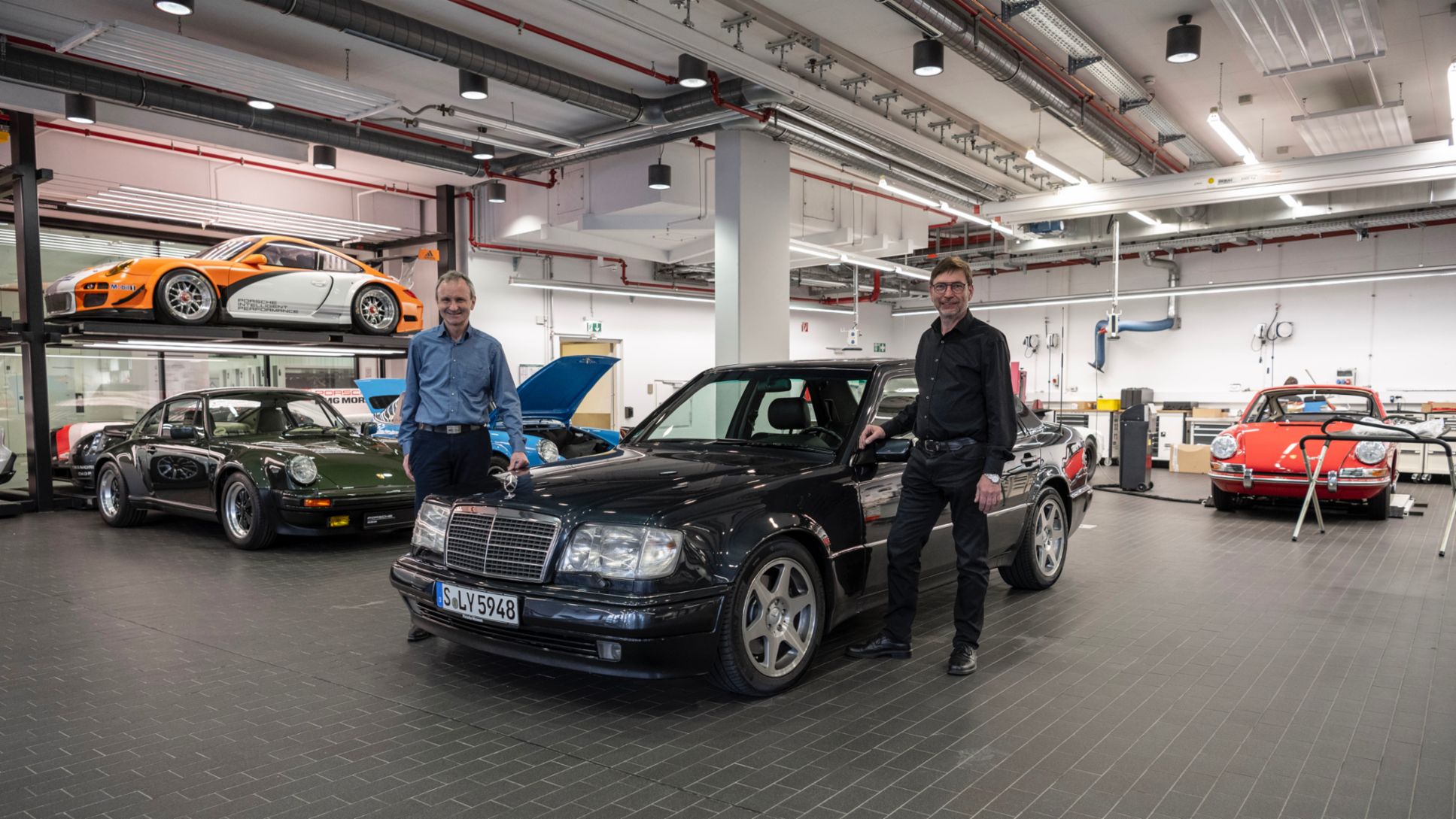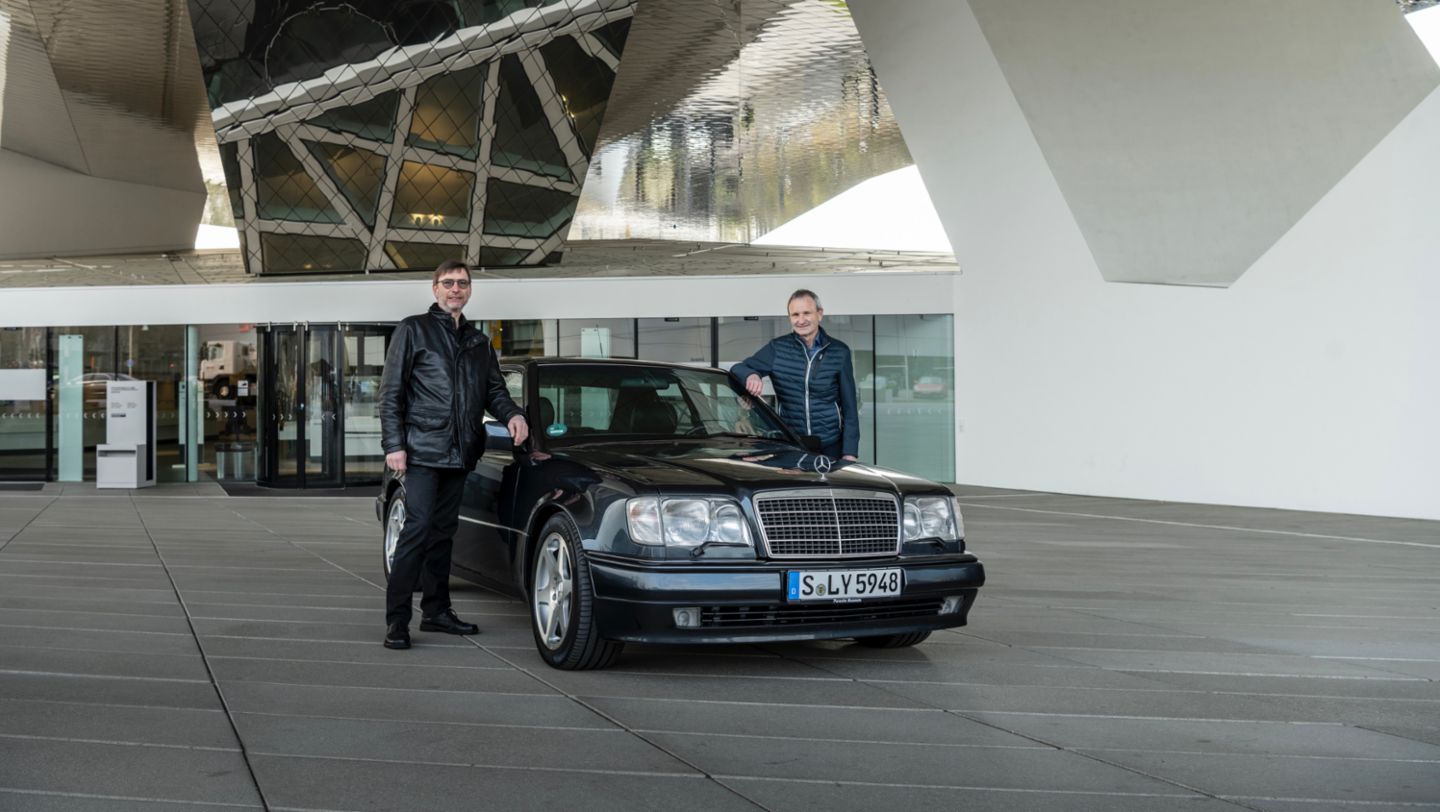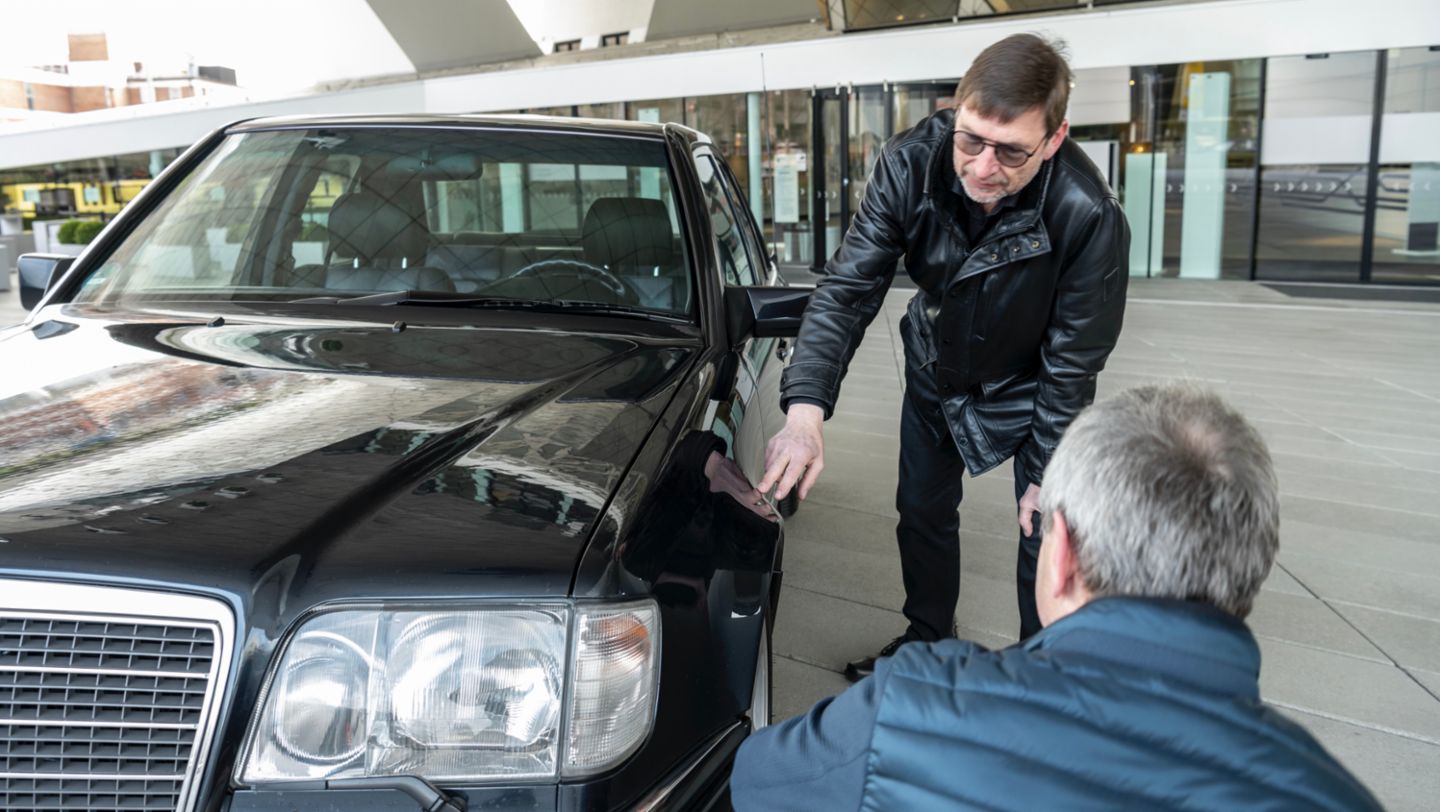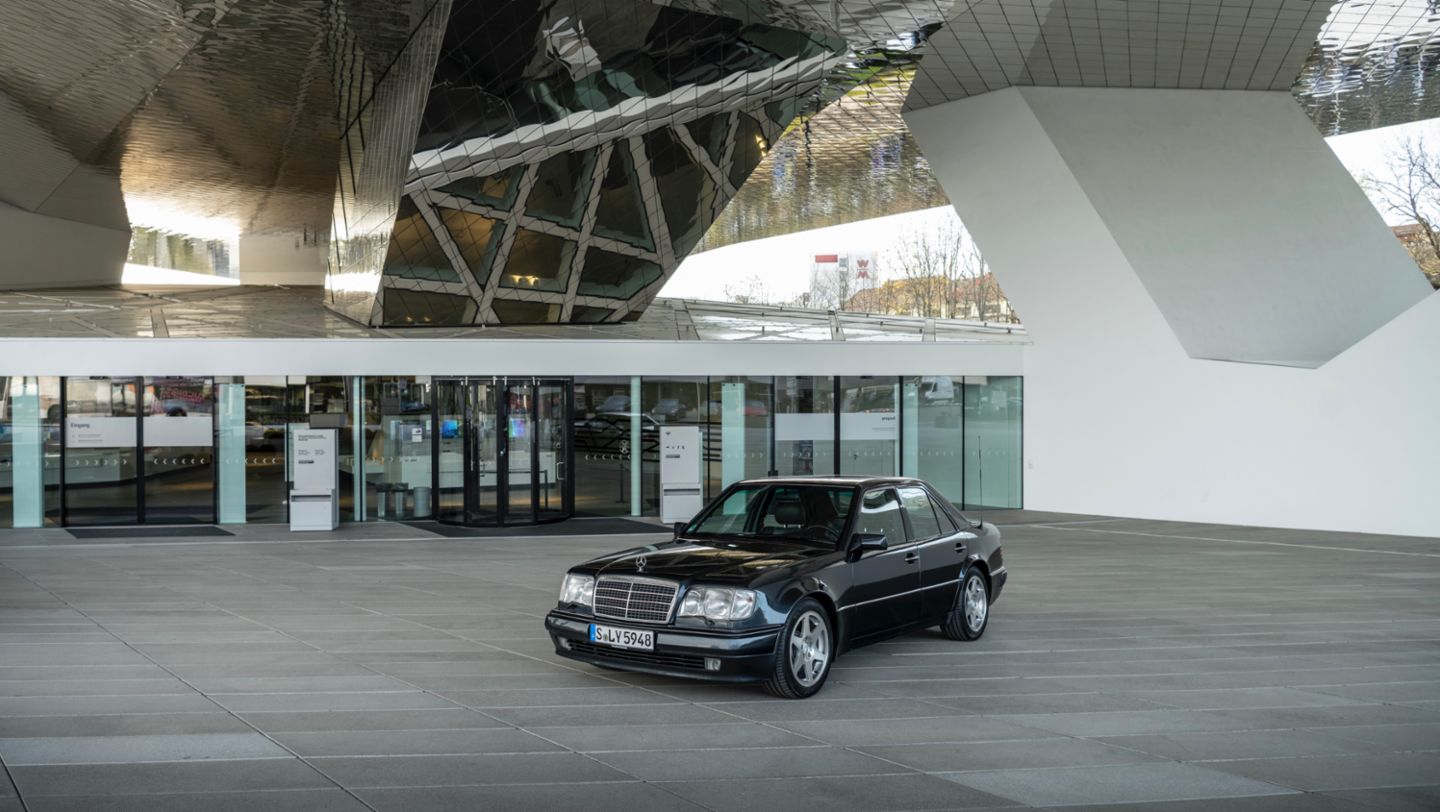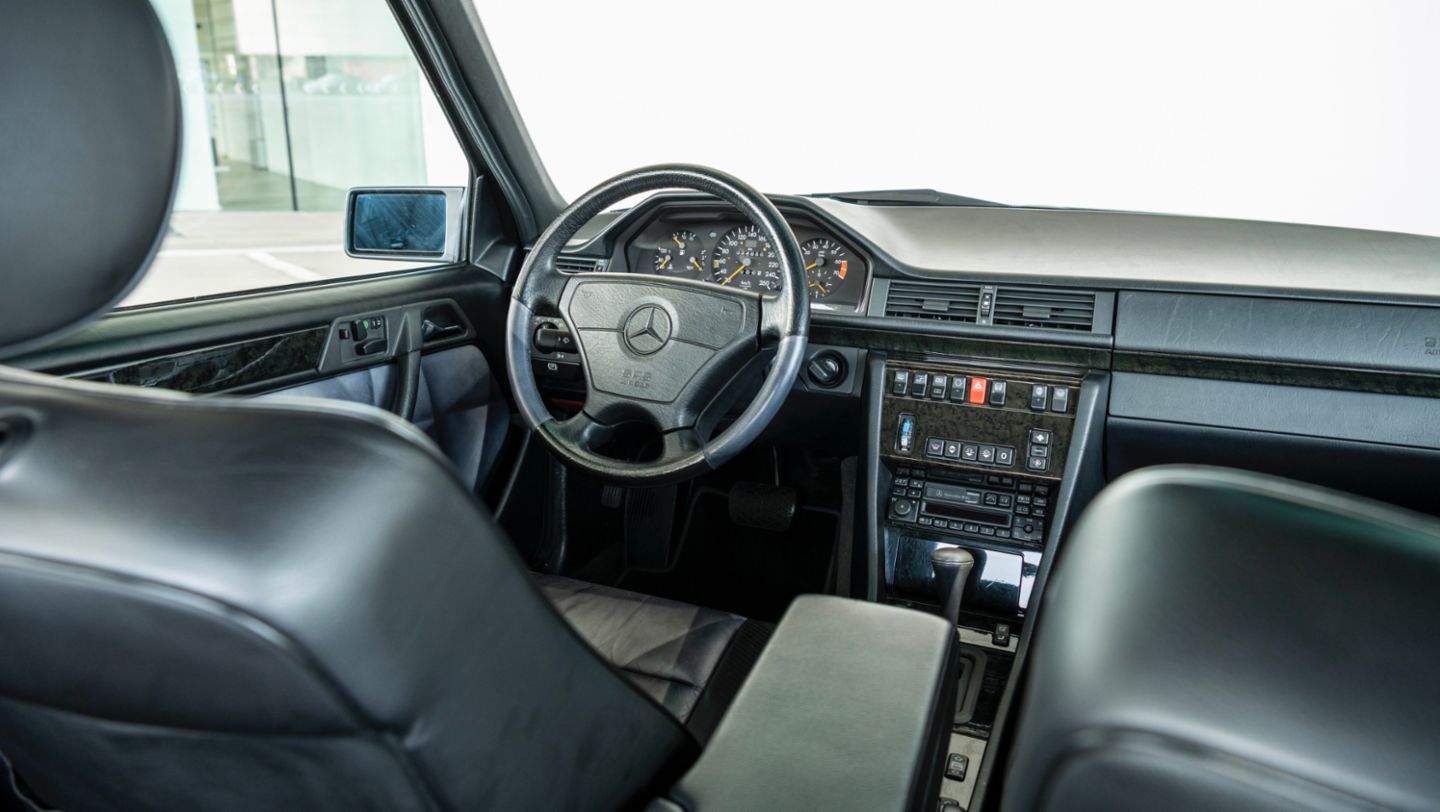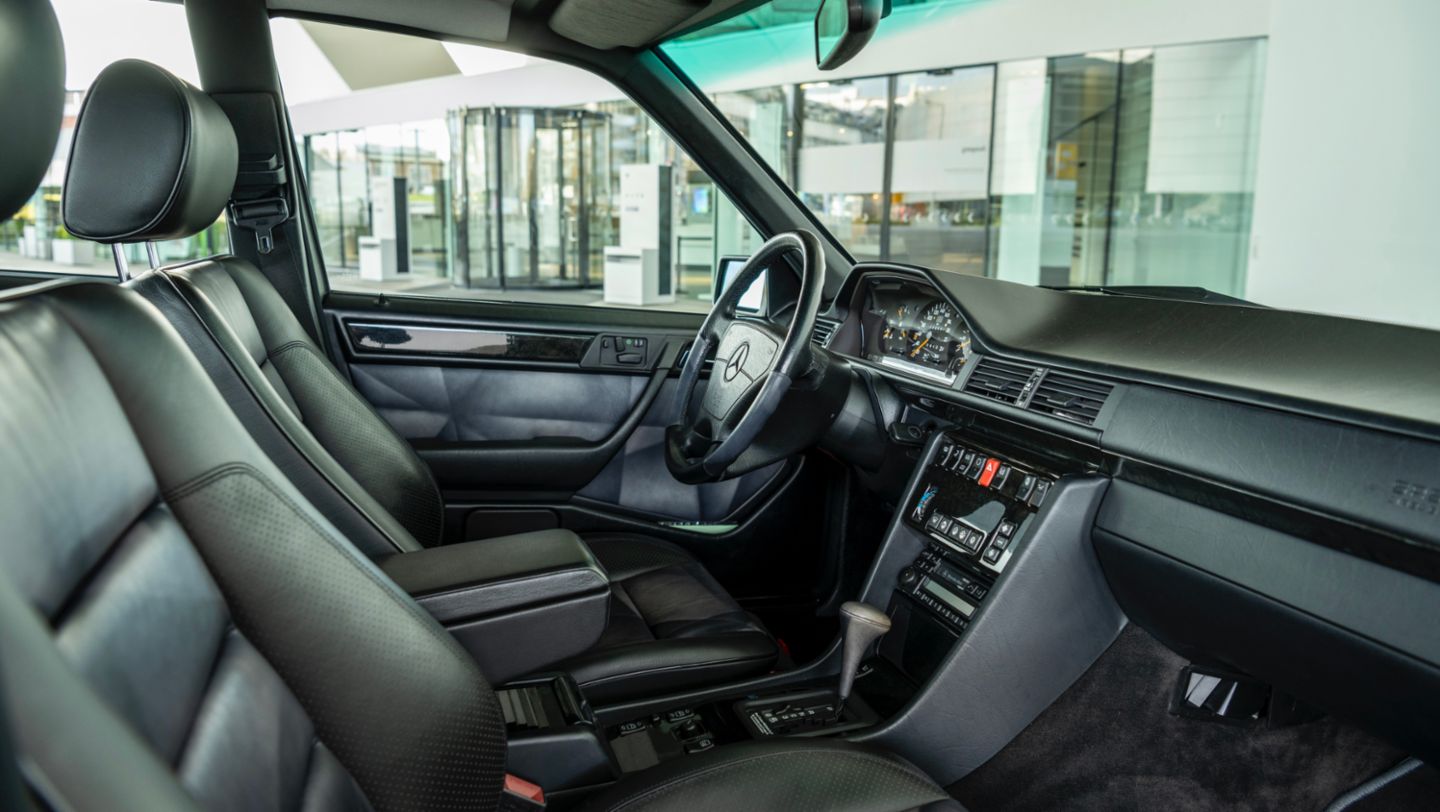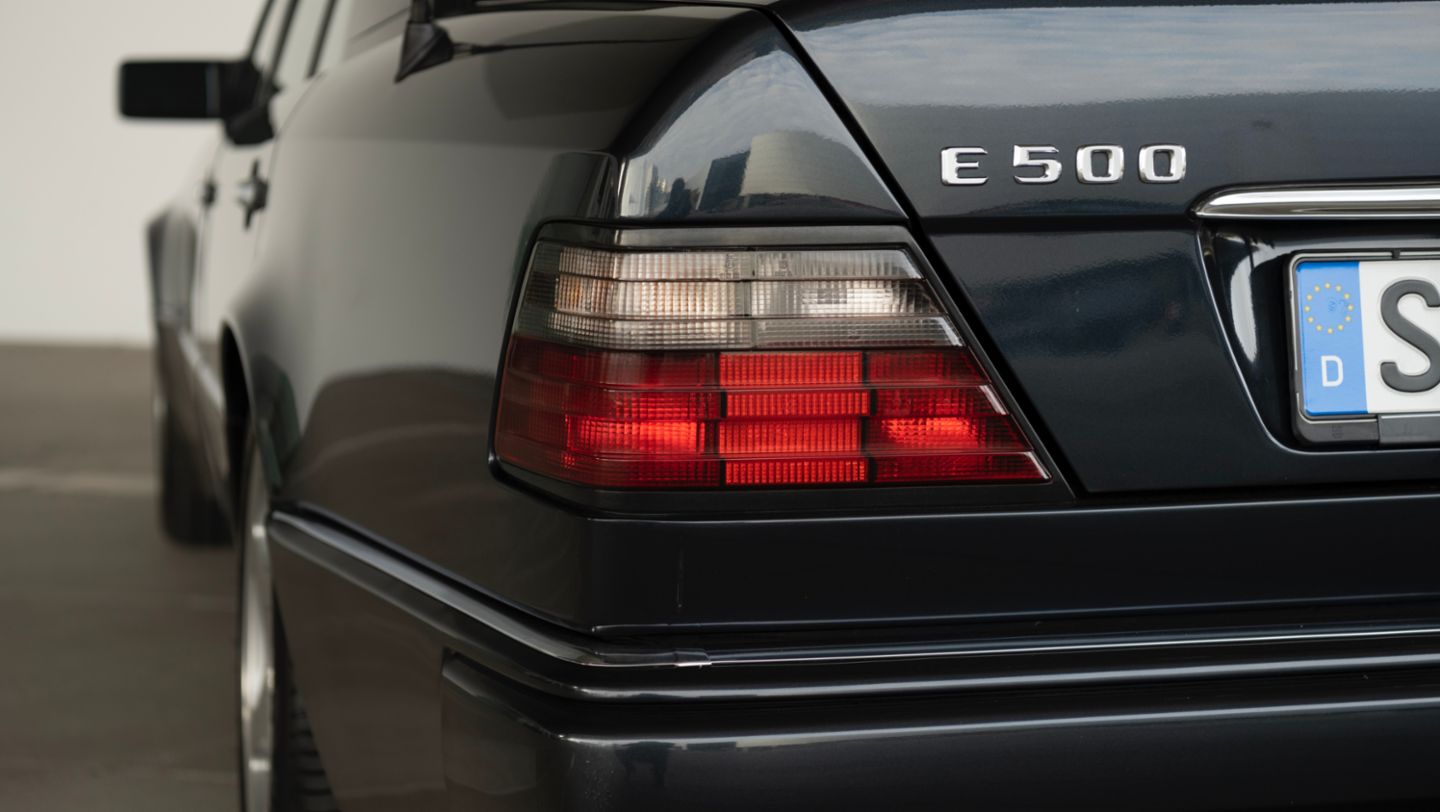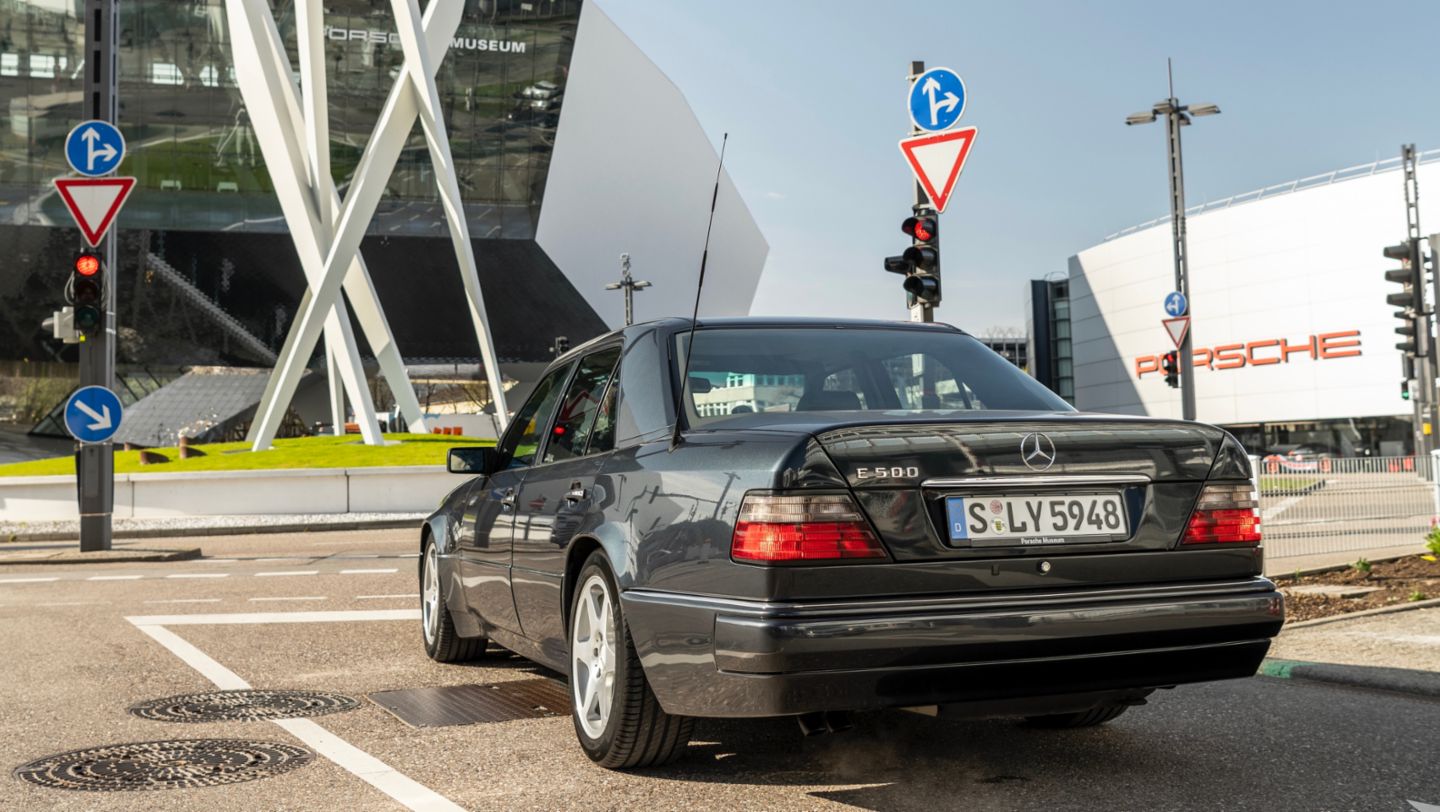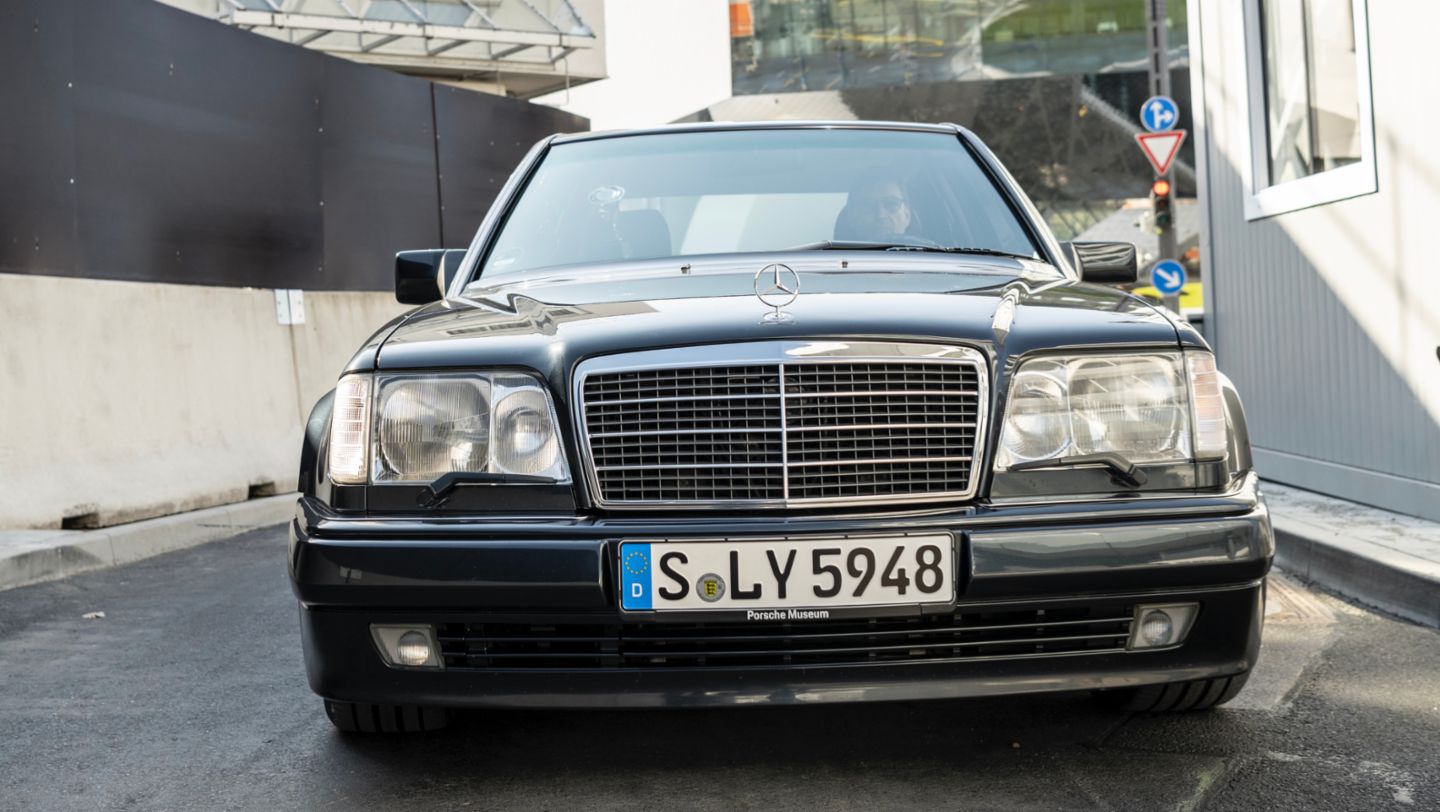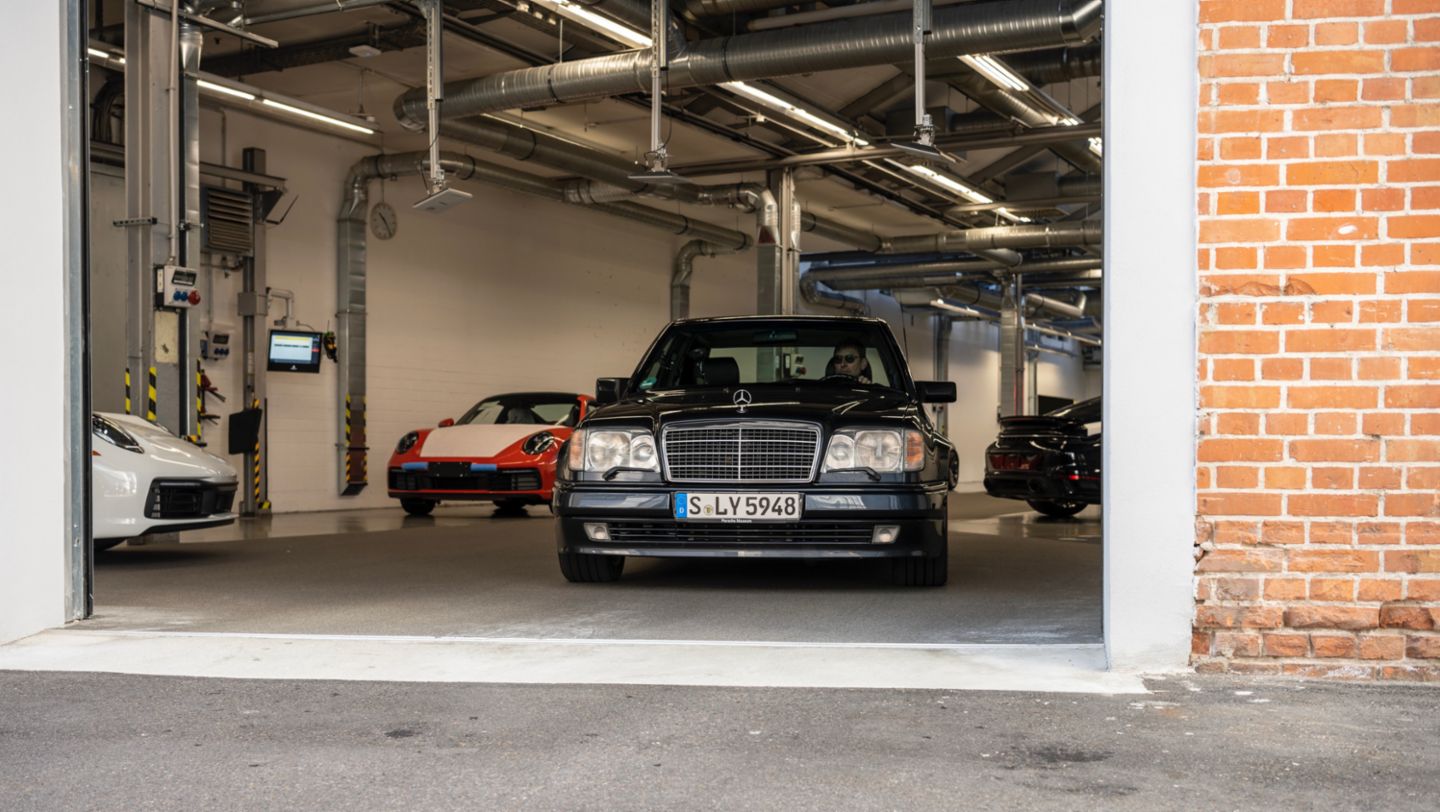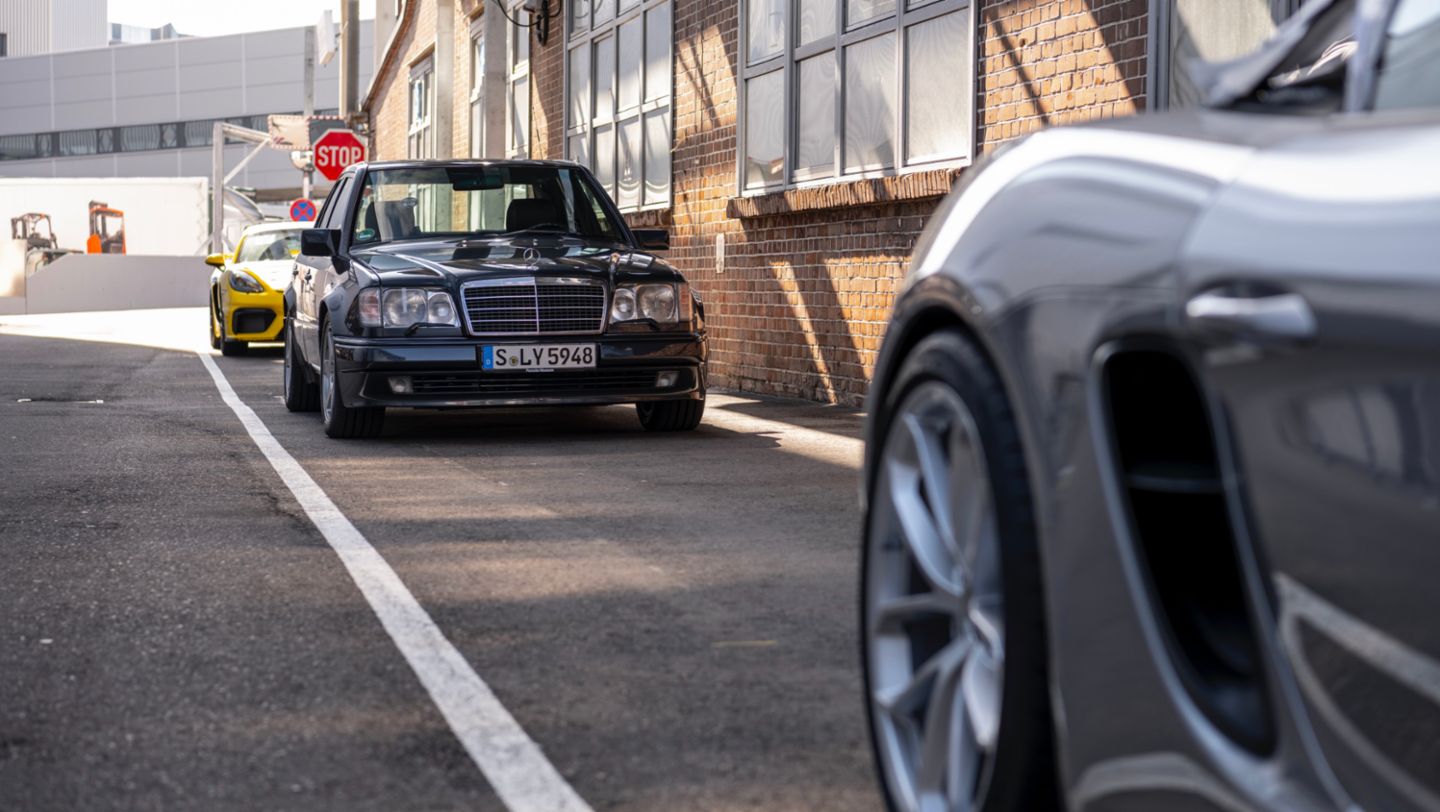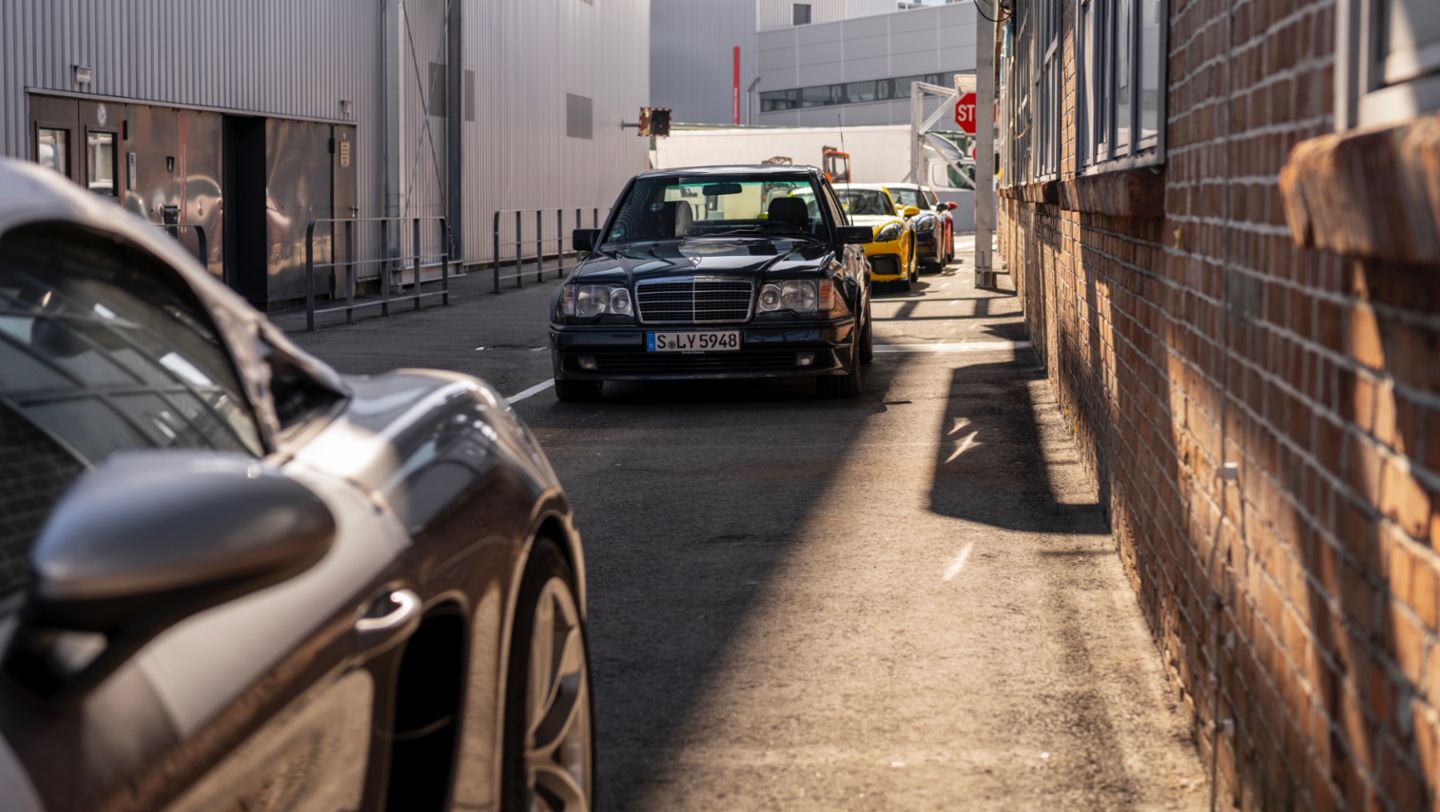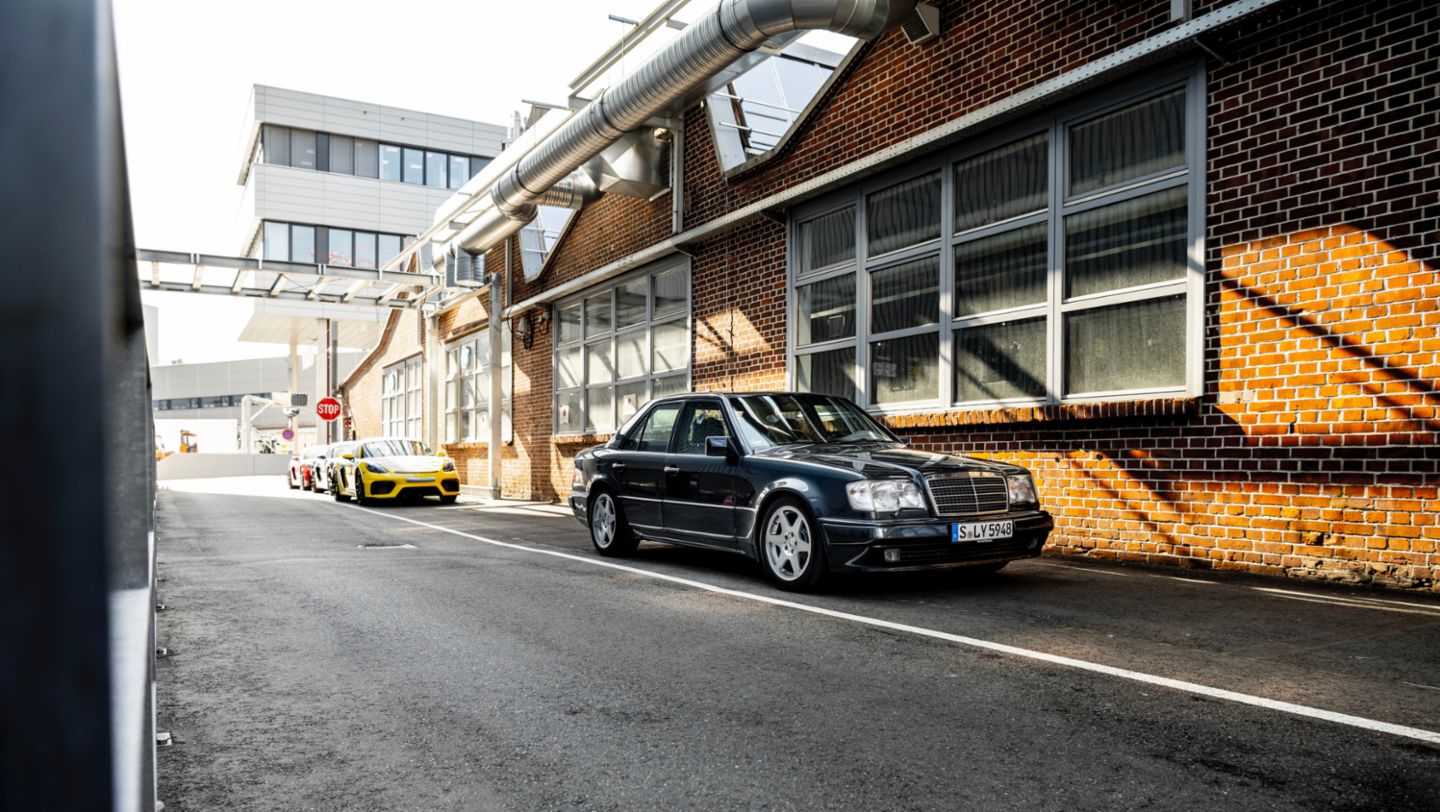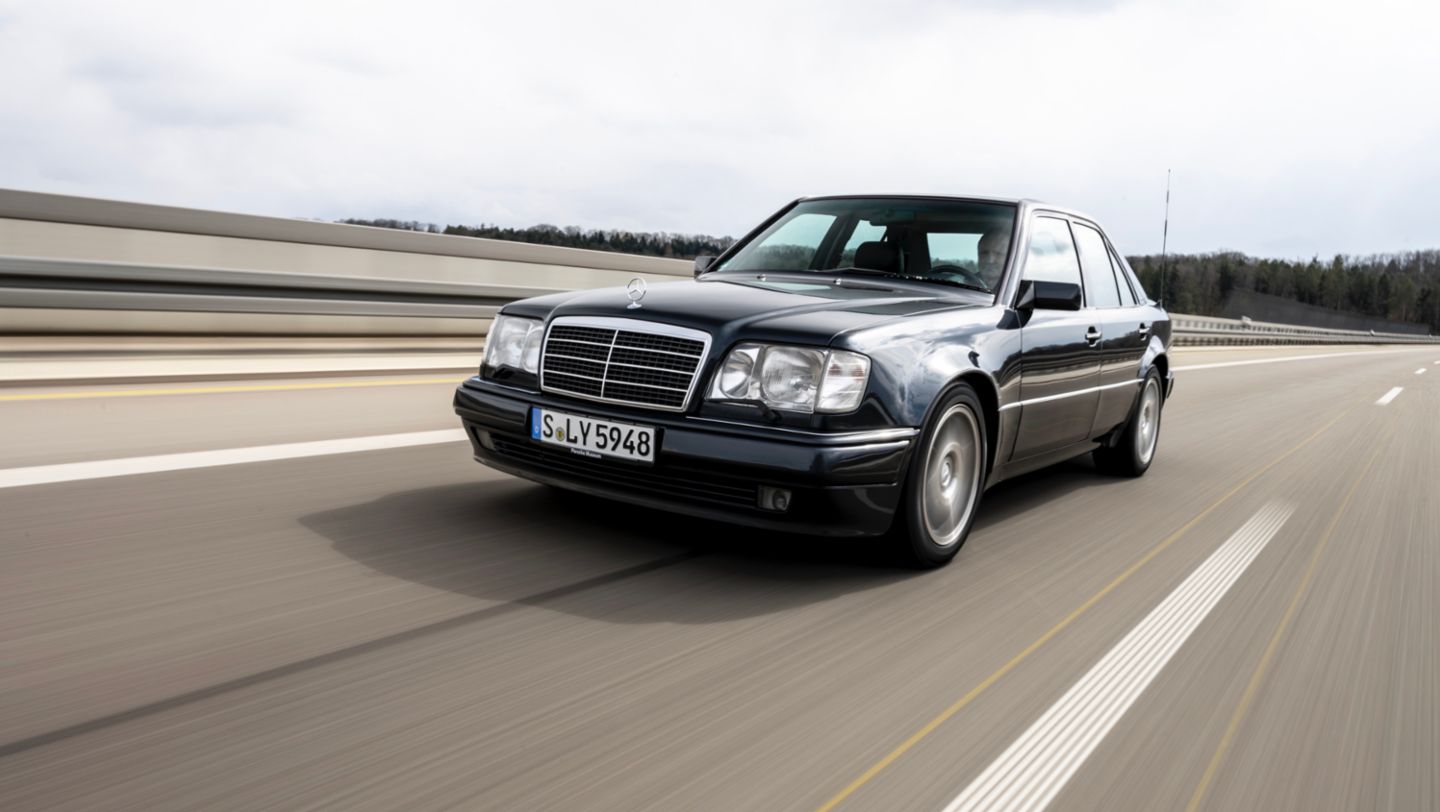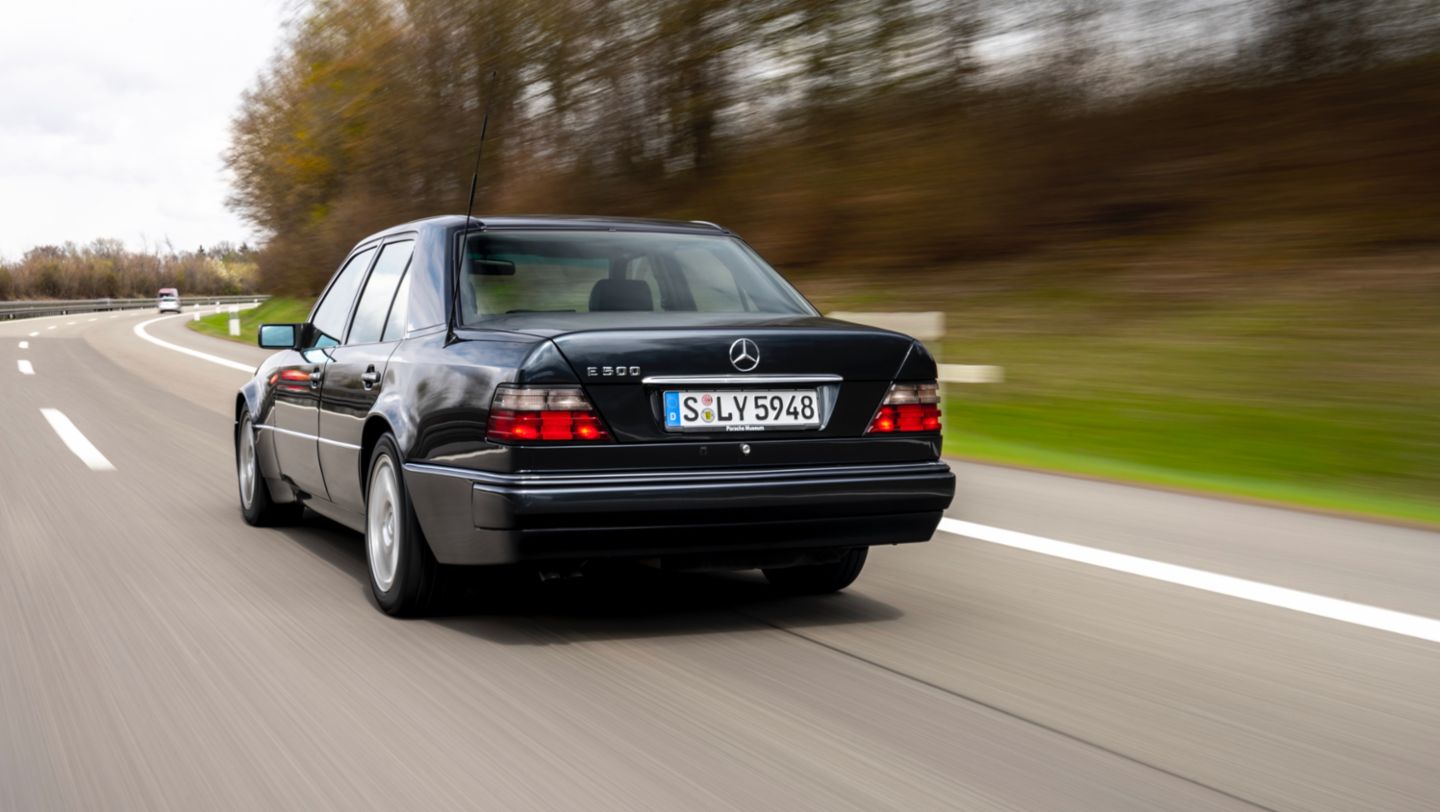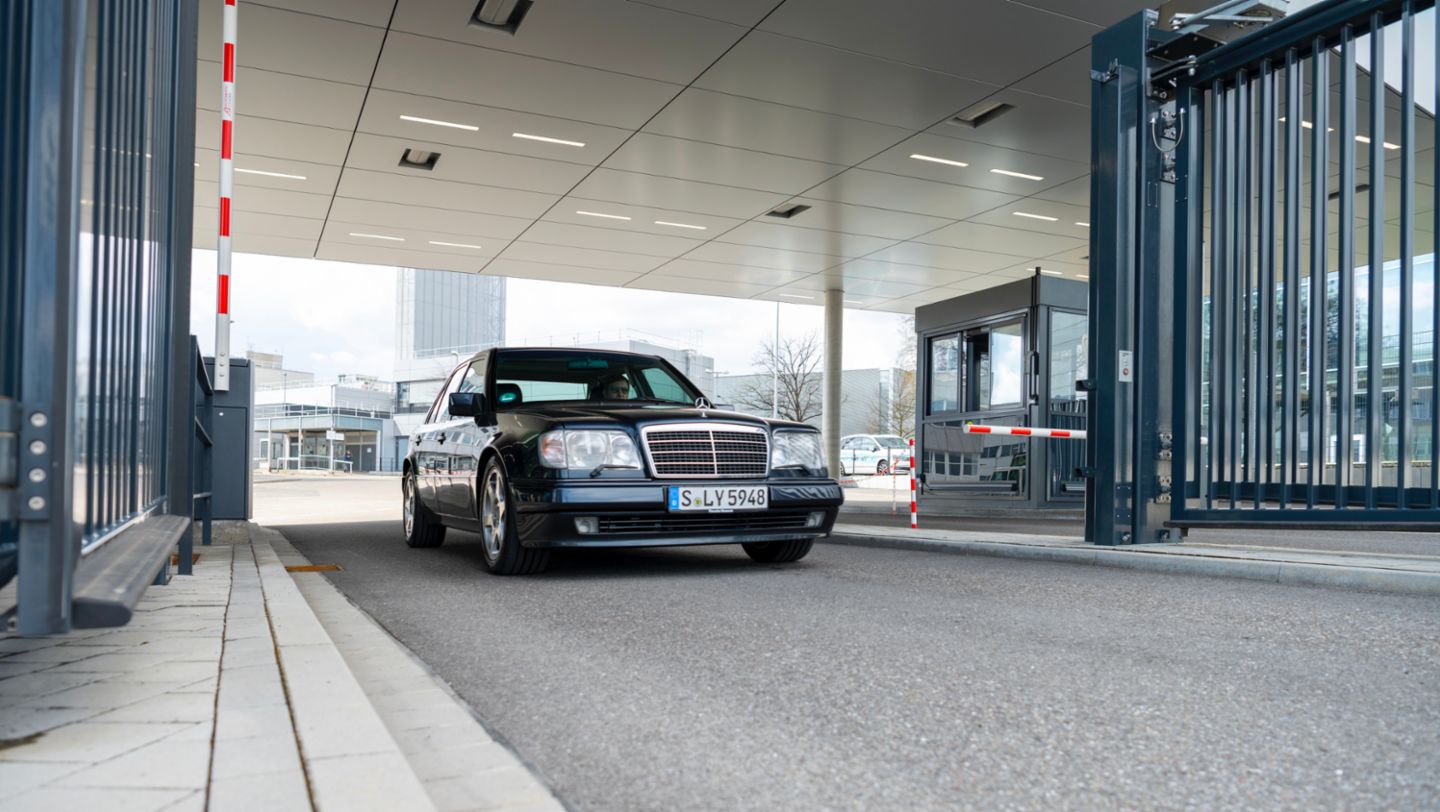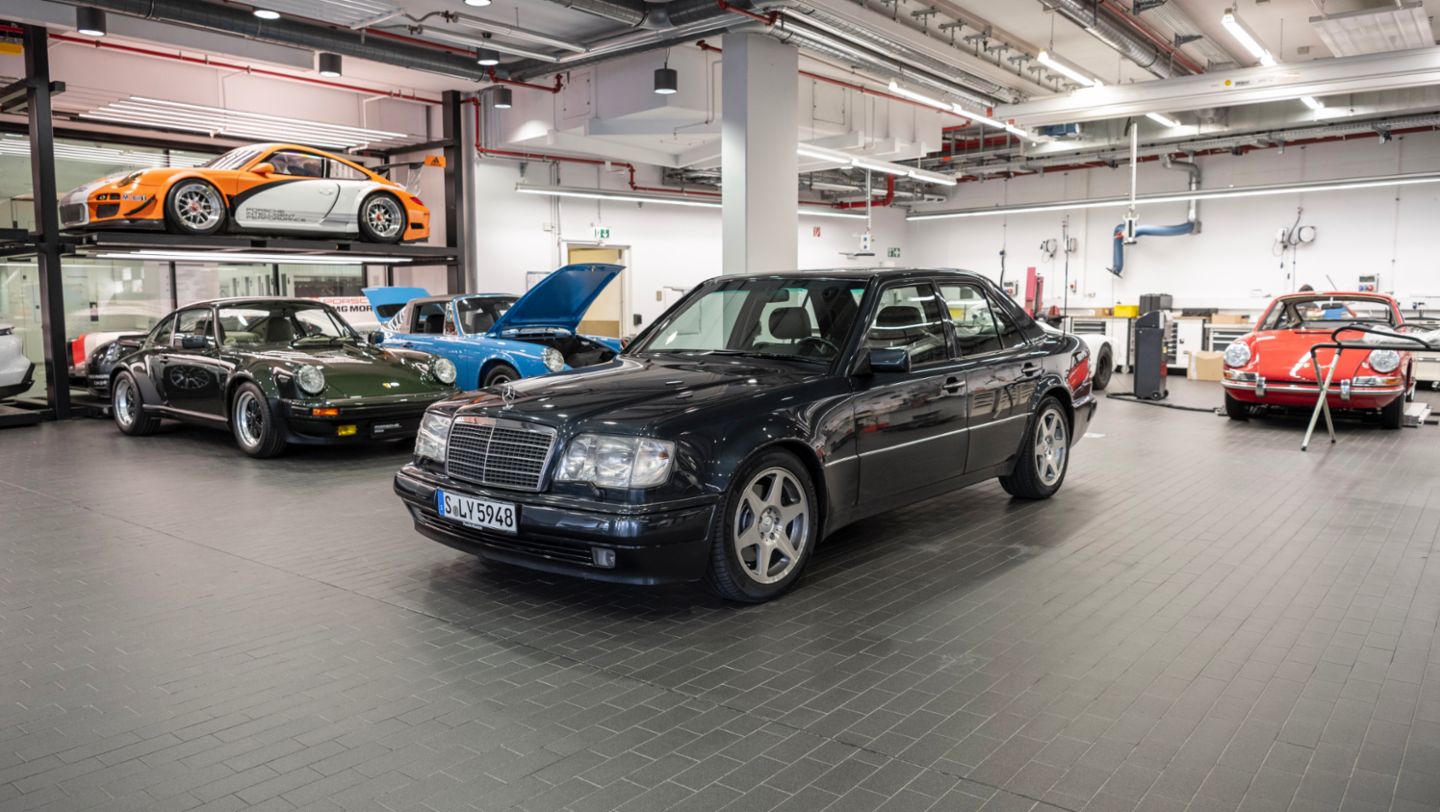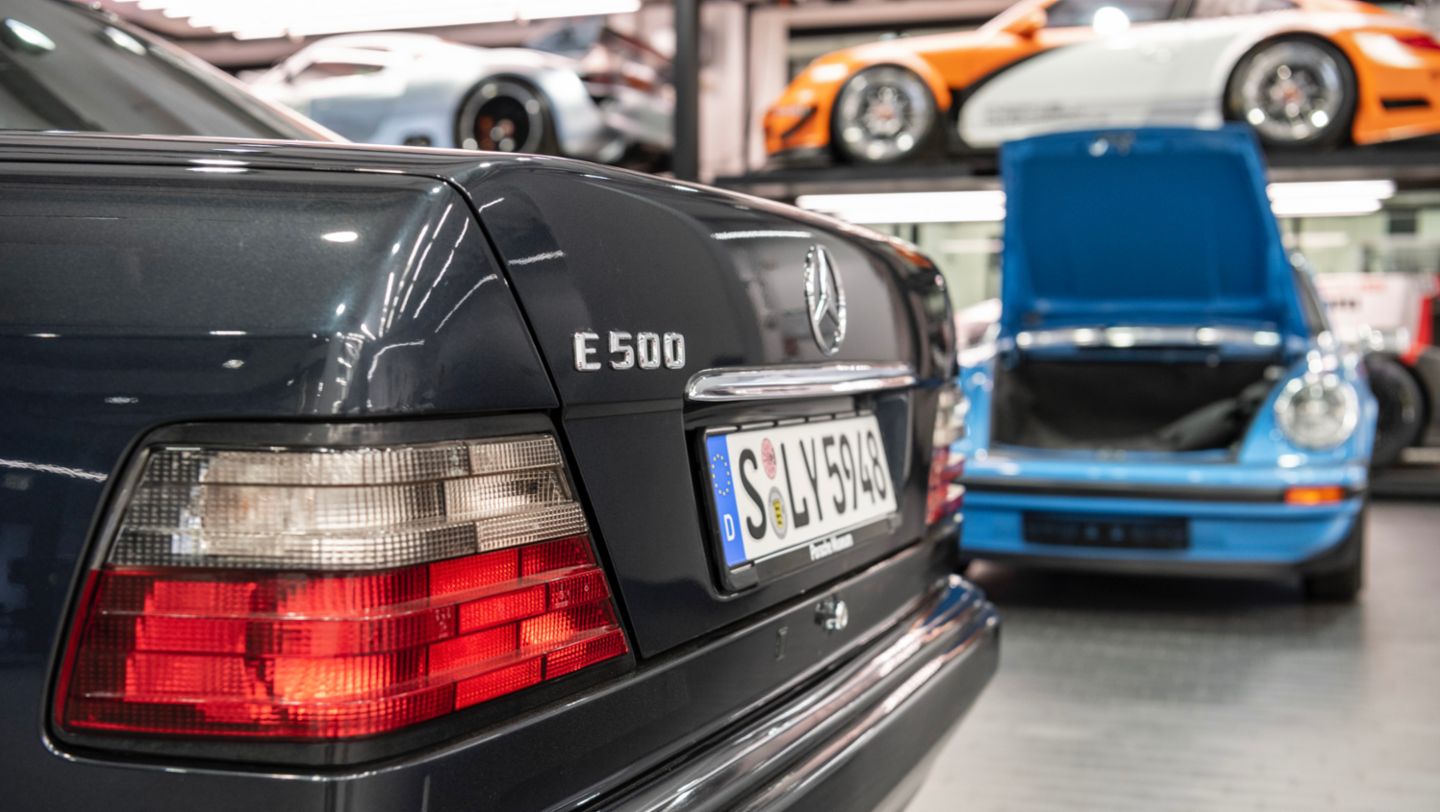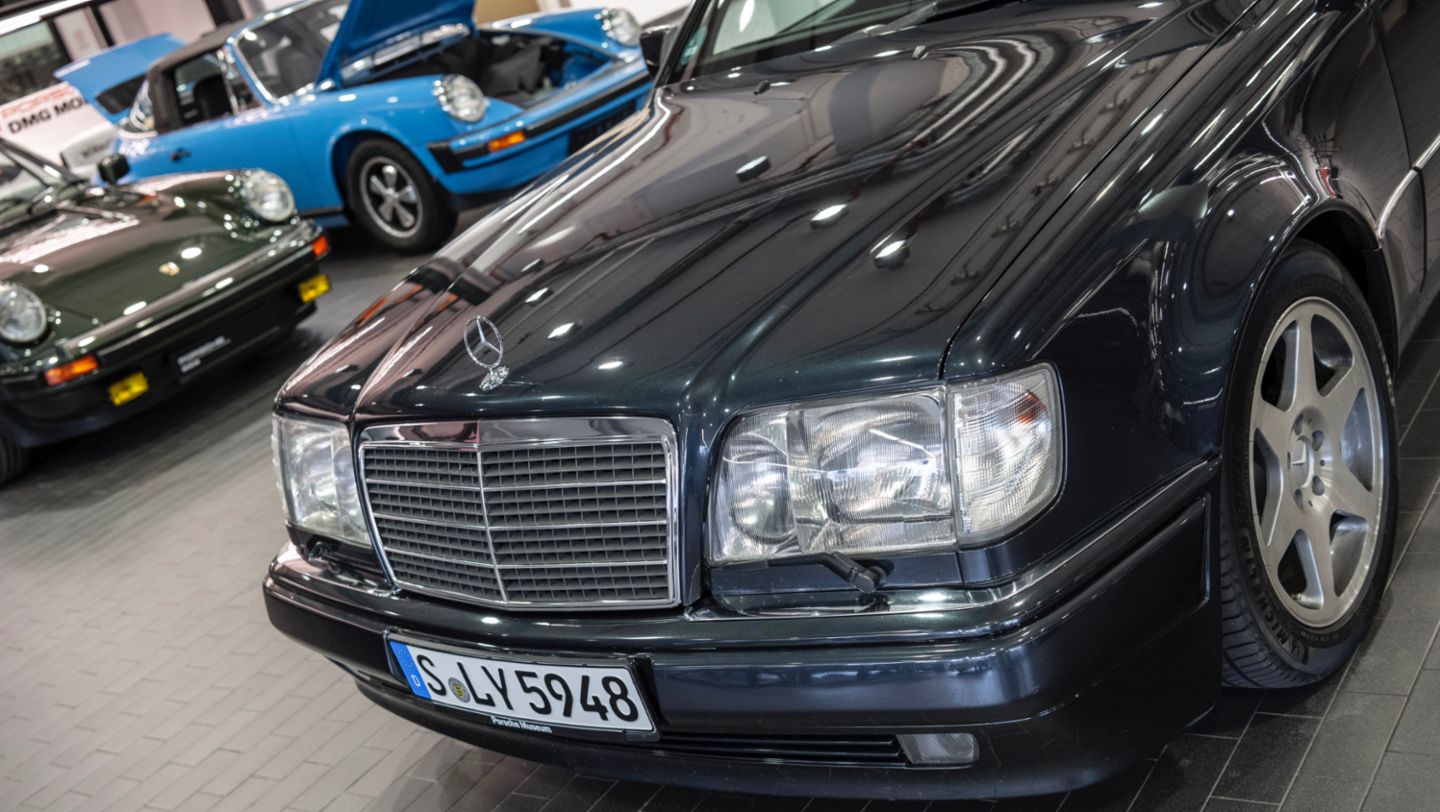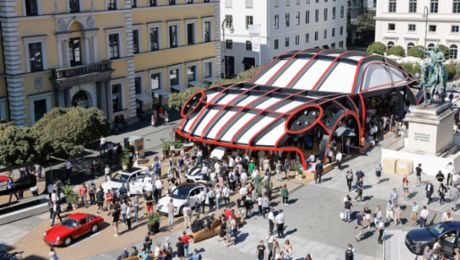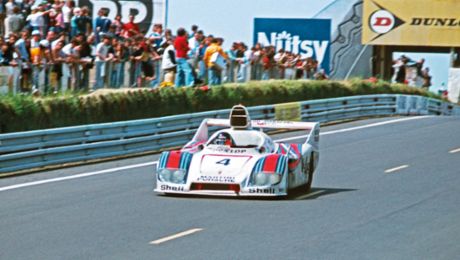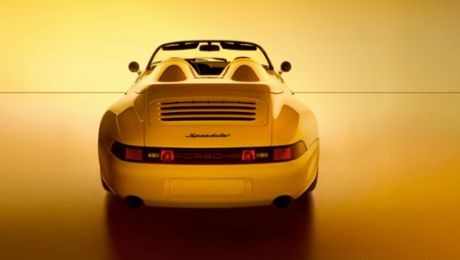After impressing the public at the Paris Motor Show in 1990, the 500 E went on sale in the spring of 1991, combining the comfort of a touring saloon with the performance of a sports car. To mark the car’s 30th birthday – and the fact that it has now reached classic status – the Porsche Museum sent two of the team involved in its creation on a journey to discover the exciting story of how it was developed.
Michael Hölscher, Project Manager Development, and Michael Mönig, from Prototype Management, last sat in the 500 E almost three decades ago. Today, they have 100 kilometres to cover, taking in Zuffenhausen, Weissach and Sindelfingen on the way. Their route starts and ends at the Porsche Museum and when they arrive, the 500 E is waiting outside, reflected in the building’s striking mirrored ceiling. Its exterior is finished in Black Pearl Metallic (colour code 199), while inside is a mix of leather, wood, colourful door trims, electrically adjustable sports seats and a cassette radio.
“Looking at the car today, it’s almost impossible to believe that the design could be so perfect 30 years ago without CAD data. I have enormous respect for my colleagues in the body shop and especially their vision,” says Hölscher as he looks the saloon over like an old friend he hasn’t seen in far too long. He and Mönig keep crouching down, marvelling at the pronounced wings – one of the features that distinguishes the 500 E from the production models of the 124 series.
In 1988, Porsche AG was awarded the development contract by Daimler-Benz AG in Untertürkheim, an outer district of Stuttgart. The technical specification laid down the requirements for “design and experimental series development of the base type W124”. The vehicle was to be equipped with the five-litre V8 four-valve engine from the 500 SL. By April 1995, 10,479 examples had been built – all of them four-seaters, because the differential was so large that there was no room for seat suspension in the middle of the rear bench.
A superior touring car
The two men still have fond memories of the 500 E to this day. “Thirty years ago, I drove to Lake Constance with three colleagues. We spent the entire trip talking to each other. At one point, one of them looked at the speedometer and had quite a shock when he realised the needle was showing 250 km/h. We had tuned the chassis, brakes and engine to perfection, which meant a superb driving experience was guaranteed,” recalls Hölscher. There were extensive discussions about the brakes at the time, the men remember. During the prototype phase, the team opted for more powerful brakes than those on the base vehicle to ensure optimum brake balance.
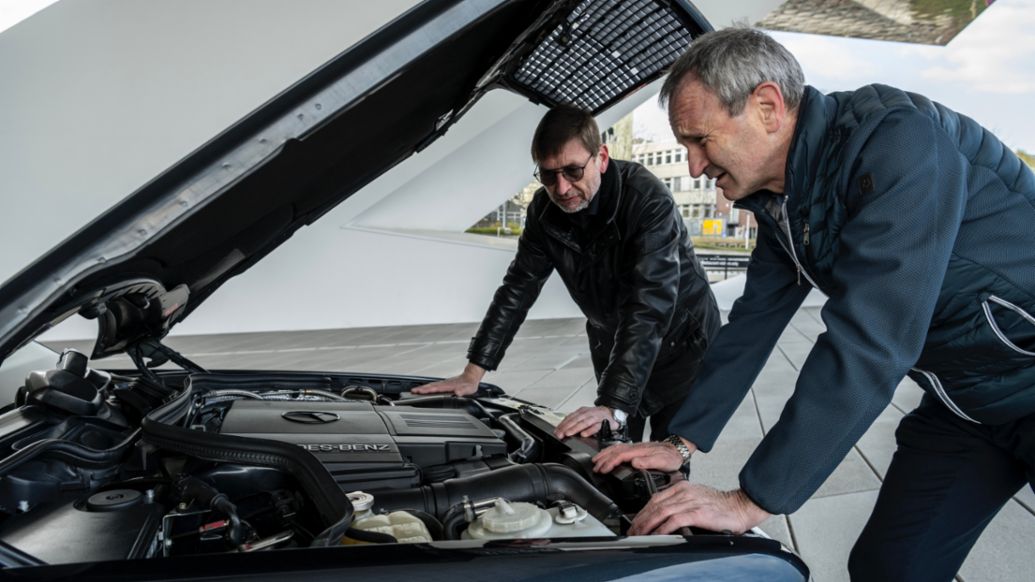
With its standard four-speed automatic gearbox, the 500 E sprinted from zero to 100 km/h in just 5.9 seconds with a power output of 326 PS (240 kW) and a maximum torque of 470 newton metres. Its top speed was electronically limited to 250 km/h. “Plenty of power, but without being ostentatious, both dynamic and luxurious at the same time. The 500 E is not a showy vehicle. It represents pure understatement, and catches the eye only at second glance,” Mönig says of the flagship model in the series. He and Hölscher set off for the second stop on their journey – the former Reutter building – just a few metres from the Porsche Museum.
The body assembly line in the Reutter building
“The order was very important for us in order to ensure good capacity utilisation in Zuffenhausen and Weissach,” remembers Hölscher, leaning against the brick wall of the former Reutter building. From 1990 onwards, the bodies were manufactured right there, in the Reutter building of Werk 2 in Zuffenhausen. This building was empty at the time and offered sufficient space for a body assembly line for the 500 E.
The procedure was clearly defined: Mercedes-Benz supplied body parts from Sindelfingen to Zuffenhausen. In Werk 2, the Porsche team then assembled the body with these components and with parts manufactured in-house, such as the distinctive front wings. The bodies then travelled back to Sindelfingen, where they were painted. After this, the cars were completed in the Rössle Bau in Zuffenhausen, where final assembly and engine installation took place. The production process took 18 days, and each 500 E made the journey from Zuffenhausen to Sindelfingen twice. “From a logistical point of view, sending the vehicle parts back and forth was a big challenge. After all, the relevant parts had to arrive at the right place at the right time,” explains Hölscher.
Project launch in the middle of a crisis
The timing of the cooperation between the Stuttgart-based car manufacturers could not have been better. Porsche was facing a crisis due to a decline in revenue from export business, falling production and key performance indicators that were almost all negative. “One of the lessons from the project in those difficult times was that you should always take on every challenge. We were able to keep the team together with orders like these,” recalls Hölscher, who worked at Porsche from 1982 to 2016, when he took early retirement. At the start, the sports car manufacturer produced ten vehicles a day; due to the demand, those responsible soon increased this to 20. “Here we are at counting point 0, the birthplace of the 500 E,” says Mönig. Installation of the chassis, gearbox and engine – a process known as the ‘marriage’ – took place at point 4, while counting point 8 was delivery.
Seeing the vehicle go into series production was one of the best moments for the two men who witnessed this at the time. Visiting the former Reutter building brings back memories. Hölscher: “The 500 E was the first project I was responsible for that went into series production. Three decades later, it is as if I am watching the vehicles roll off the production line.” He also looks back fondly on the fact that his team was allowed a lot of freedom to work on their own initiative. Apart from the fact that they are both passionate car and motorbike enthusiasts, what does he have in common with his colleague Mönig? “We met back then through the 500 E and went on to manage several other projects together. It was a big part of my life and a very important one,” says Hölscher.
Astonishing performance
At the end of the 1980s, Daimler-Benz AG commissioned Porsche as a development service provider – today known as Porsche Engineering – because its own production line for the 124 series in Sindelfingen was too small. The wider body of the 500 E, which was later renamed the E 500 as part of a model update, meant that the former could not produce the car itself. Modification of the production equipment would not have been worthwhile for the company. The intention was that the 500 E should look like a W124 at first glance and at the same time set new standards – for connoisseurs, a high-performance saloon of the kind never seen before. It was 56 millimetres wider than the base vehicle and 23 mm lower. At Porsche, the 500 E was given the working title Project 2758.
Mönig, who has worked for Porsche for more than 35 years and was responsible for building the prototype of the 500 E, takes the wheel – but not without listening to his former colleague’s impressions of driving the car first: “Thirty years have passed, and a lot has happened in the automotive industry in this time yet even today the 500 E has nothing to hide. Its handling is magnificent. The longitudinal acceleration is excellent, the brakes are outstanding and it’s a pleasure to drive this car with its dynamic character. I really enjoy the beautiful and unobtrusive sound of the eight-cylinder engine.”
After arriving at the Weissach Development Centre, Hölscher parks in front of what used to be the design engineering office, known as the hexagon. It was one of the first buildings at the site and is the third stop on their trip. “Being here feels like coming home,” he says, as he hands the keys to Mönig for the rest of the journey.
Modified headlights for drawing in air
Weissach is where Mönig’s team carried out all the development work on the 500 E in the late 1980s. He and his colleagues converted the first 14 base vehicles there by hand. From the 15th vehicle onwards, assembly took place in Building 1, the prototype construction building at the time, with newly designed bodyshell parts and modified series parts. Production of demonstration vehicles helped Mercedes-Benz to take the decision to go into series production. “We planned development of the 500 E here and worked hard to make it possible to fit the large engine into the comparatively small vehicle,” recounts Hölscher. In order to achieve better weight distribution, the battery was moved out of the engine compartment and was installed at the rear right of the luggage compartment. The brake and exhaust systems were significantly modified, and the wings and bumper trim at the front and rear were revamped. The eight-cylinder engine breathed through the gap surrounding the two headlights so that it had a plentiful supply of air. With a 90 per cent development share, Porsche was responsible for practically all work that was necessary for integration of the drive and vehicle components.
The journey continues from Weissach to Sindelfingen, to the fourth stop on the trip. Mönig seems quite overwhelmed behind the wheel. “The longitudinal dynamics are spectacular. I only have good memories of the vehicle because I was given a lot of responsibility back then as a young engineer. The 500 E was and still is my favourite project,” he concludes. Mönig speaks passionately about the feeling of lightness behind the wheel, about the audible power, about the superior driving feeling. He and his colleagues from Prototype Construction spent many weekends in Sindelfingen. Thanks to the tremendous commitment of all those involved, it was also possible to make up a delay in the tight project schedule. “The collaboration with colleagues at Mercedes-Benz was very respectful, focused and on equal terms and was based on a great desire for success,” he remembers. One key moment for him was the first day, he says, when he drove to the Sindelfingen site with his colleagues and numerous prototype parts. “That was very special.”
On the way back to Zuffenhausen, he listens to the V8 engine with the window open a crack. Later, once he has parked it in the museum workshop, he will have plenty to say about the superior performance that continues to set the 500 E apart three decades later. Until then, he simply enjoys the feeling of being on the road.
